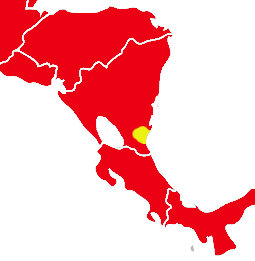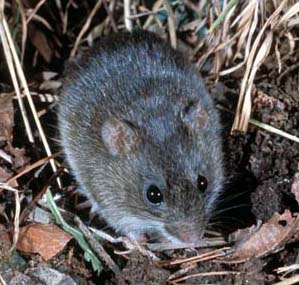Nicaraguan oryzomys facts for kids
Quick facts for kids Nicaraguan oryzomys |
|
|---|---|
| Conservation status | |
| Scientific classification | |
| Genus: |
Oryzomys
|
| Species: |
dimidiatus
|
 |
|
| Range of Oryzomys dimidiatus (yellow) and the related O. couesi (red and yellow) in Central America. | |
| Synonyms | |
|
|
The Oryzomys dimidiatus, also called the Nicaraguan oryzomys or Nicaraguan rice rat, is a small rodent. It belongs to the family Cricetidae, which includes many types of mice and rats. This special rat has only been found three times. All these finds were in southeastern Nicaragua since 1904.
When it was first discovered, scientists thought it belonged to a different group called Nectomys. Later, they realized it was a unique type of Oryzomys. It is now known to be related to other Oryzomys species, like the marsh rice rat and Coues' rice rat. Coues' rice rat lives in the same area.
The Nicaraguan rice rat is a medium-sized rice rat. Its head and body are about 110 to 128 mm (4.3 to 5.0 in) long. Its fur is gray-brown on top and grayish underneath. This is different from O. couesi, which has buffy (yellowish-tan) underparts. The tail is only a little darker on top than on the bottom. All three rats found were near water. This suggests they might be semiaquatic, meaning they spend some time in the water. Scientists currently list its conservation status as "Data Deficient". This means we don't have enough information to know if it's endangered or not.
How Scientists Classify This Rat
Scientists group living things into categories. This helps us understand how they are related. The first Nicaraguan rice rat was found in 1904. The next year, a scientist named Oldfield Thomas described it. He named it Nectomys dimidiatus. He thought it was like other Nectomys rats, but much smaller.
Years later, in 1948, another scientist named Philip Hershkovitz studied the rat. He decided it was actually part of the Oryzomys group. He even put it in its own special subgroup. Later, scientists found that O. dimidiatus is closely related to the marsh rice rat (Oryzomys palustris).
In 2006, many species that were once in the Oryzomys group were moved to other groups. This happened because they were not closely related to the main Oryzomys species. However, O. dimidiatus stayed in the Oryzomys group.
Today, Oryzomys dimidiatus is one of eight species in the Oryzomys group. It is part of a smaller section that includes O. couesi. O. couesi is common in Central America. The O. couesi section also has six other species that live in smaller, specific areas. O. couesi and O. dimidiatus both live in southeastern Nicaragua. Scientists are still learning about these groups. They think there might be even more types of these rats than we know now.
The name Oryzomys dimidiatus comes from Greek and Latin words. Oryza means "rice," and mys means "mouse" or "rat." Dimidiatus means "divided in the middle."
What the Nicaraguan Rice Rat Looks Like

The Nicaraguan rice rat is a medium-sized rat. It is smaller than O. couesi. It has thick, shiny fur. The fur on its back is about 6 mm long. Its upper parts are gray-brown with some dark hairs. This makes it look darker than O. couesi. Its sides are a bit more yellowish.
Its underparts are grayish. This is different from O. couesi, which has yellowish-tan underparts. The rat has a short snout. Its ears are covered with fur and are partly hidden. Its hands and feet are off-white or brownish. They are not white like those of O. couesi. Its back feet have small webs between the toes. However, they do not have long tufts of hair on the toes. Some of its foot pads are also smaller or missing.
The tail is about the same length as its head and body. It has about 15 rings per centimeter. The tail is slightly darker on top (grayish) than on the bottom (whitish). But this color difference is not as strong as in O. couesi.
The rat's skull is light. It has a narrow nose bone and a wide, round braincase. The braincase does not have strong ridges. The front part of the roof of its mouth has holes called incisive foramina. These holes are widest at the back. The molars (back teeth) are not as simple as those in Nectomys species. The front bumps on the first molars are not divided into two parts.
Scientists have measured the first two rats found. The first rat (from 1904) had a head and body length of 125 mm (4.9 in). Its tail was 115 mm (4.5 in). Its hindfoot was 27 mm (1.1 in). Its ear was 13 mm (0.51 in). The second rat (from 1966) had similar measurements. It weighed 46.0 g (1.62 oz). A third rat was found later. It had a head and body length of up to 128 mm (5.0 in). Its tail was up to 150 mm (5.9 in). Its hindfoot was up to 31 mm (1.2 in). Its ear was up to 19 mm (0.75 in).
Where the Nicaraguan Rice Rat Lives
The Nicaraguan rice rat has only been found in southeastern Nicaragua. This area is in the lowlands of the South Caribbean Coast Autonomous Region.
The first rat was found in 1904. It was in a banana farm with very wet red clay. This was near the Río Escondido river, close to El Rama. The second rat was caught in 1966. It was in thick cane plants near the Río Mico river at El Recreo. This spot was about 15 km (9 mi) west of where the first rat was found. Other types of rice rats and a rabbit were also found there. The third rat was caught near a stream close to Bluefields.
Because all three rats were found near water, scientists think they might be semiaquatic. This means they spend some of their time in the water, like other Oryzomys rats.
In 2019, the IUCN Red List looked at the conservation status of Oryzomys dimidiatus. They listed it as "Data Deficient". This means we do not have enough information about this species. We need more research to know if it is at risk of disappearing.


